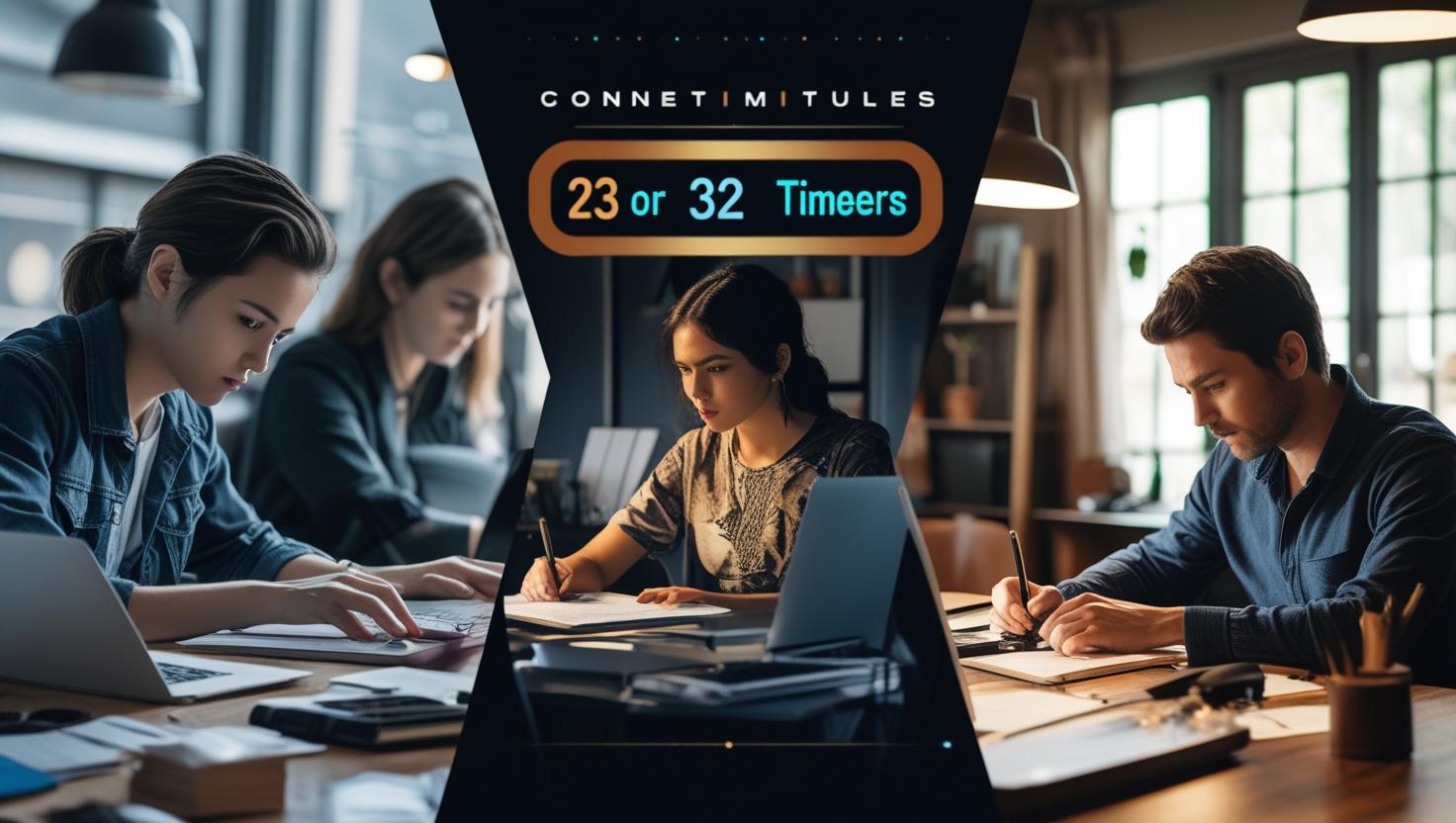What Are the Best Use Cases for 23 or 32-Minute Timers in Work or Study Sessions?

What Are the Best Use Cases for 23 or 32-Minute Timers in Work or Study Sessions?
In today’s fast-paced world, productivity isn’t just about doing more, it’s about doing what matters in focused, intentional blocks of time. That’s where odd-timed sessions like set 23 minutes timer and 32 minutes timer come in. For professionals involved in organizing conferences, meetings, or webinars, these unconventional durations can significantly enhance time management and improve session engagement.
Whether you’re a CXO planning team check-ins, a marketing manager prepping speaker rehearsals, or a webinar ops team juggling back-to-back sessions, using structured countdowns like a set timer 18 minutes or set a timer for 19 minutes can bring powerful results. And with platforms like Let’s Time IT, these countdowns can be scheduled and displayed discreetly at scale making session timing efficient, remote-controlled, and non-intrusive.
In this blog, we’ll dive deep into the most impactful use cases for these time blocks and how event organizers can use them smartly across different environments.
Why Use Odd Timers Like 23 or 32 Minutes?
Timers like 8 min timer or 32 minutes may seem arbitrary at first glance, but behavioral research shows they work well for human attention spans. Here’s why:
- 23 minutes timer is long enough to focus deeply but short enough to prevent burnout.
- 32 minutes timer provides a slightly extended work session perfect for completing slightly more complex tasks without the fatigue of a full hour.
- These time frames fit well with how humans manage mental energy, short bursts of high concentration followed by breaks.
Timers such as a countdown clock 5 minutes are often used as break buffers in between these focused blocks.
Use Case 1: Structured Focus for Panel Discussions and Speaker Prep
When preparing panelists or speakers backstage at an event, a timer for speakers with a specific preset like set 8 minute timer ensures that everyone rehearses within the same time limit. Similarly, a stagetimer with a 23 minutes timer works excellently for dry-runs where multiple people need to rotate in and out swiftly.
Timers bring consistency and structure essential in high-pressure environments.
Ideal For:
- Speaker preparation
- Last-minute briefing sessions
- On-stage rehearsal slots
Use Case 2: Productive Work Sprints During Conference Planning
Planning an event involves juggling dozens of tasks: vendor calls, speaker confirmations, email drafts, guest list reviews. A 32 minutes timer can be used for deep work sprints for each task, where team members are fully focused on one item.
Organizers and marketing leads can run 3-4 such sprints a day, using tools like a remote-controlled countdown timer to avoid micro-management and let teams self-manage their time.
Ideal For:
- Drafting marketing content
- Reviewing presentation slides
- Managing registration workflows
Use Case 3: Managing Delegation and Audience Engagement Sessions
For webinars and hybrid events, managing breakout rooms or short Q&A segments becomes more efficient when timed. For example:
- Set 18 minute timer for live polls and Q&A
- Set a timer for 19 minutes for feedback or reflection activities
These segments can be discreetly managed using event scheduling platforms that allow hidden or silent countdown timer tools. This is particularly useful when you want the host to know the time limit without distracting attendees.
Ideal For:
- Webinar polls
- Moderated Q&A rounds
- Breakout room tasks
Use Case 4: Transition Windows and Buffer Time
Between back-to-back speaker sessions or meetings, you often need transition time. That’s where a countdown clock 5 minutes is perfect for backstage teams and emcees.
Meanwhile, session hosts can set a timer for speakers to reset and prepare without rushing the process. These micro-timers are especially useful when managing large-scale multi-session events like summits and expos.
Use Case 5: Personalized Time Management for Executives
Many CXOs and team leads use stagetimer tools or event timer apps for their own work routines. By running a 23 minutes timer or 8 min timer, they can segment their day more effectively:
- 8 minutes for scanning key headlines or decks
- 23–32 minutes for replying to priority emails or reviewing campaign performance
Over time, these become mini-routines that drive more output with less fatigue.
Platform-Based Implementation: Discreet Timing Across Systems
If you’re wondering how to implement these timers practically during an event, webinar, or internal meeting especially across platforms like Google Calendar, Outlook, or Apple devices Let’s Time IT offers scalable, browser-based scheduling:
- You can manage mass timer scheduling for hundreds of sessions.
- Countdown timers can be shown on backstage screens or shared silently with moderators.
- Add timers alongside your Countdown timer for addevent integrations so that participants know when a session starts or ends.
This type of smart timer integration eliminates confusion, ensures time-bound discipline, and supports better event flow.
Conclusion: Precision Timing = Peak Performance
Using timers like set timer 18 minutes, 32 minutes timer, or even a short countdown clock 5 minutes isn’t just about staying on time it’s about optimizing how people engage with their tasks, speakers, and goals. Whether you’re orchestrating a virtual conference or managing a hybrid seminar, intelligent use of countdown timers elevates your productivity and professionalism.
As an organizer, building routines using remote-controlled countdown timer tools and integrating them seamlessly across sessions empowers your team and speakers to stay focused without losing track of time.
Try experimenting with 8 min timer sprints for daily workflows or a set a timer for 19 minutes slot for content reviews. The results will speak for themselves.
Let’s Time IT is designed to help you schedule, trigger, and manage countdown timers for all types of professional events discreetly, at scale, and with absolute precision.